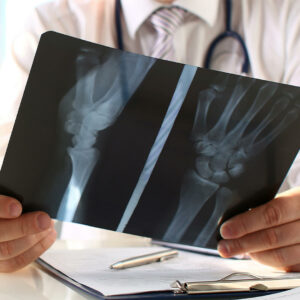Understanding Pediatric Fractures and How They Heal

No one moves more than a child. And if yours is suffering from a bone fracture, you want them feeling better (and moving freely) as soon as possible. At Orlin & Cohen, that’s our goal, too. And just like there are so many ways to fracture a bone (falling off a trampoline, anyone?), each fracture has its own category and treatment plan.
Dr. Danielle Magrini, a fellowship-trained pediatric sports medicine specialist at Orlin & Cohen, explains the pediatric bone fracture classification system, treatment options, and the steps we take to ensure your child’s bone heals properly.
What Is the Salter-Harris Classification System?
The Salter-Harris Classification System (named after two orthopedic surgeons who developed it) is used to measure pediatric fractures in children and adolescents.
This type of classification system is needed because bones continue to grow until a young adult is between 16 and 18 years old. As a result, a pediatric fracture doesn’t just affect the bone but could also impact how the bone grows. This system classifies the severity of the injury to the growth plate, a region of cartilage at the end of bones where growth occurs.
The 5 Salter-Harris Fracture Types
Depending on what part of the bone is injured, it correlates with a specific grade of fracture.
Type 1
Widely considered the most harmless, Salter-Harris type 1 rarely causes a problem with how the bone grows. This type of fracture occurs through the growth plate and does not involve the bone itself.
Type 2
Salter-Harris type 2 is the most common type of fracture. This fracture goes through the wide portion of a long bone and the growth plate. Similar to type 1, this type of fracture has a good prognosis and usually does not cause a problem with bone growth when treated properly.
Type 3
Salter-Harris type 3 goes through the end part of a long bone and growth plate. Surgery is often required to fix it. Fortunately, this type of fracture is uncommon, and less than 8% of growth plate fractures are classified as type 3.
Type 4
Salter-Harris type 4 breaks vertically through the growth plate, the wide portion, and the end of the long bone. In most cases, surgery is required to repair the break for healthy bone growth.
Type 5
Salter-Harris type 5 causes the highest degree of injury to the growth plate. Thankfully, it’s also the most rare. With type 5, there is no break to the growth plate; instead, it is directly compressed. Children with type 5 injuries are closely monitored throughout the healing process.
Diagnosing Salter-Harris Fractures
Your doctor will figure out what type of fracture your child has by completing a medical exam and reviewing diagnostic images.
X-rays
If your child fractures a bone, they’ll need an X-ray. This imaging will help your doctor look at the bone from various angles. Then, they’ll be able to classify the fracture correctly and determine how best to treat it.
At Orlin & Cohen, diagnostic imaging is part of your comprehensive orthopedic care, and every Orlin & Cohen location has an X-ray machine. Your child’s results are available within minutes, so your child can begin treatment as soon as possible.
Treatment approaches
Based on which bone your child fractured, what caused it, and the type of fracture they have, your doctor may recommend these options:
- Splints and casts: These are used for slight fractures, typically including Salter-Harris fracture types 1 & 2. It holds the bone in place while it heals but is more flexible than a cast.
- Brace: The most commonly used brace is a walking boot. Braces can stabilize the fractured bone and can be used before surgery or as a way to avoid it.
- Sling: These devices help support the bone to keep it from moving. Slings are commonly used on arm, shoulder, or elbow fractures.
- Surgery: If your child’s fracture is severe, as is the case with Salter-Harris fracture types 3 through 5, surgery might be the best treatment option to correct damage to the growth plate.
Healing time
The healing time varies based on the type of fracture and the age of your child. Johns Hopkins Medicine says young children can heal from a fracture within three weeks, but it could take up to six weeks for teens to recover from the same type of fracture.
Rehabilitation
Wondering how to help your child while they heal from a fracture? Nemours Children’s Health shares a few tips on how you can improve your child’s rehabilitation:
- Promote strong, healthy bone growth with a diet rich in calcium and vitamin D
- Take good care of the cast, splint, brace, and incision site
- Make sure your child rests until your doctor says it’s OK to get back to their daily activities
- Go to all your follow-up care visits, including physical therapy appointments, if your specialist recommends it
From examinations with expert pediatric orthopedic care to providing advanced treatment and rehabilitation, we’re here to help your child heal. Request a same-day appointment or walk in for immediate after-hours care in Merrick, Bohemia, or Garden City.



